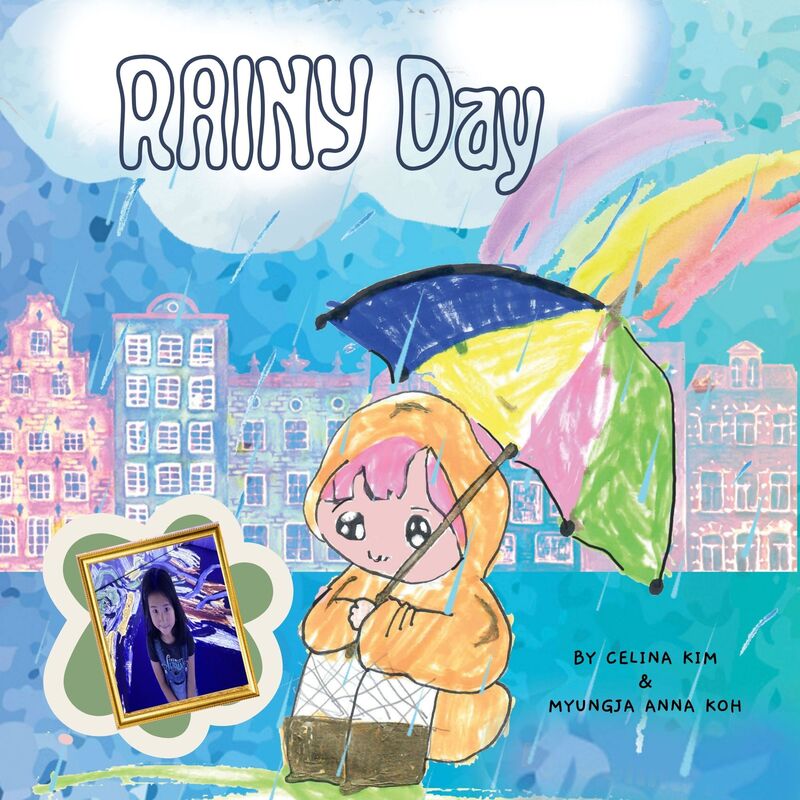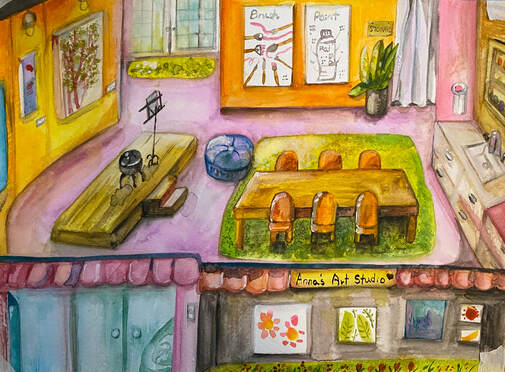My dream Art Studio Through my master's study, I discovered core philosophies and methodologies that would be helpful for my future art studio making. After all, through the journal "Handout on choosing art media in the early childhood classroom," I discovered that the art environment and the composition of art materials are crucial to promoting art language. A child's rudimentary knowledge of regularly using paint and brushes to make strokes, mixing colors, and covering paper all contributes to a repertoire of personal experiences. Therefore it will be the basis for children's future artistic activities. In other words, when I design my future art studio, I will first prepare various types of brushes with this in mind. I have been teaching my children the types and characteristics of brushes in detail. I have often witnessed artists who have been painting for over 30 years still need to become more familiar with the names and attributes of each brush. Artists should be taught in detail the first tool they use: the brush. So, as shown below, I have been making illustrations for children and getting them closer to the brush through a matching game. Kids love this game very much. I will put a poster for this matching game on the wall. And it will let them experience the touch of various brushes and techniques. I will also refer to the journal I read, "The Arts in Early Childhood The Magic of the Brush and the Power of Color: Integrating Theory to Practice of Painting in Early Childhood Settings by Booyeon Lim." Among the Bank Street methods in this journal, I found that the five primary colors (yellow, red, blue, black, and white) tempera paint, which is the painting material of the Bank Street Approach, is suitable for children who are starting to draw for the first time. I recommend using these primary color tempera paints after drawing with colored pencils and crayons for children who want to learn early drawing. In addition, I plan to experience various types of paint. In my lessons, I teach them to create artistic expressions using multiple materials such as watercolor powder, ink, tempera, acrylic, and tape; the children love it. In addition, preschoolers demonstrate their two-dimensional design skills and often learn to create three-dimensional designs. Some children, by the age of 3, are experimenting with sand and sometimes clay. Therefore, for these children to know the properties of three-dimensional objects, they need various types of mediums, such as clay, cloth, and paint. I will always have this in my studio storage with this in mind. In the case of roses, I have experienced that teaching children to make and draw them, for example, in clay, has helped them understand and draw roses more clearly and easily. Children become interested in space and three-dimensional objects after drawing graphics. At this time, if these interests and needs are not met, children will be quickly disappointed and put down the brush at the lack of progress in their skills. Therefore, my future studio will be filled with many different media and ideas to enhance children's space and three-dimensionality. In addition, in the case of the Reggio Approach Reggio Emilia School in the text, more than 20 kinds of colorful tempera are used. Therefore, in my future studio, there will be as many different types of paints as possible arranged on shelves. Additionally, due to my experience living in Germany for a long time, I am immersed in Goethe's color theory and have reflected it in my works. Therefore, painting at Waldorf awakens children's inner senses, imagination, and perception of the aesthetic qualities of the colors of nature. The Waldorf method of painting is based on Goethe's color theory applied by Rudolf Steiner to Waldorf's education. "Colors have unique characteristics like living nature and appear in their rhythms and movements (Nobel, 1991)." I want to help children experience these colors' characteristics, rhythms, and energies in as many ways as possible. And to do this, one wall of my studio will consist of a gallery. Works by various artists and students are always hanging on the walls, so children naturally receive visual stimulation. And the performance stage in front of the gallery wall is structured so that children can instantly get ideas for paintings on it, perform, or create plays. And in the corner, there will always be a space for children to doodle. (For reference, there are places like this everywhere in Germany; Even in restaurants) Children's attention is critical to learning, and they retain interest when activities are appropriate to their developmental level. In other words, we need various paths that continuously give children aesthetic and artistic stimulation. And finally, through the journal "Drawing as storytelling, expression, and performance," I found an important phrase that will become the philosophy of my future studio operation.
"If children are to continue making art as adults, they must work diligently while mastering the techniques and expressive conventions of adult art that bridge the gap between the children's and adult art worlds. Children easily learn the many graphic images that are part of popular culture. With education, many children will develop beyond this level in their production and appreciation. Art educators' responsibility is to increase this level of visual impact by providing examples to children." In other words, as an educator who runs a studio and teaches art, I should do an excellent job of raising children's visual impact level. This became my philosophy, and I learned from the text Bank Street's innovative art education concept, the Reggio approach's curriculum that emphasizes art in a beautiful, healthy, and loving environment, and the good advantages of Waldorf's nature-friendly, color-based, experiential art education. And will organize the studio according to my color. In my studio, children are expected to experience a variety of art media, express themselves freely through art, receive visual stimulation in various ways, and increase their visual impact through a curriculum tailored to each developmental level. In addition to this, I think that if I mix well the method of providing solid theory from the basics step by step during art education in Korea, where I have lived for a long time, the German-style nature-friendly education method and color theory, and the art education technique I learned in the United States, my creative studio can be created.
0 Comments
Leave a Reply. |
Myungja Anna KohArtist Categories
All
Archives
July 2024
|
Proudly powered by Weebly



 RSS Feed
RSS Feed